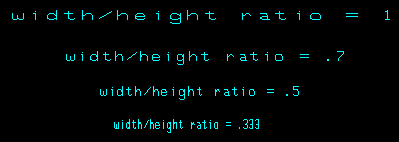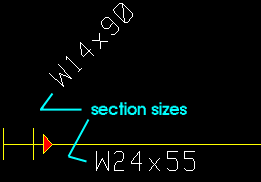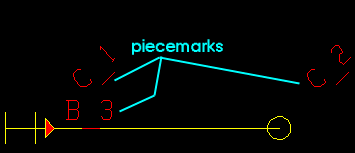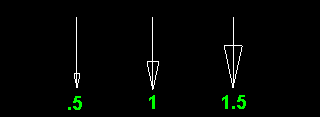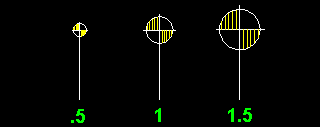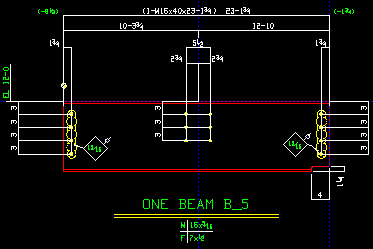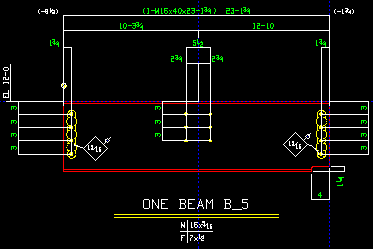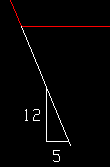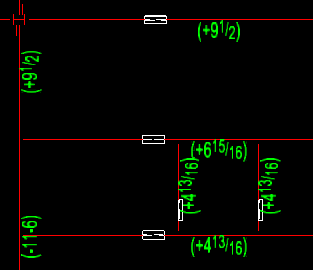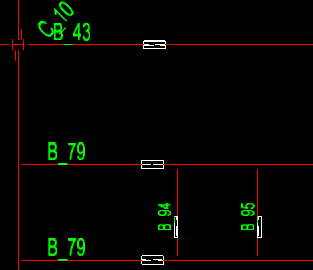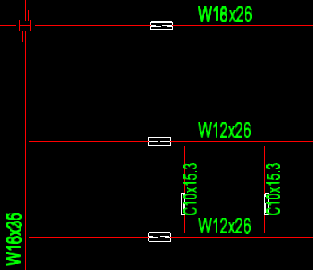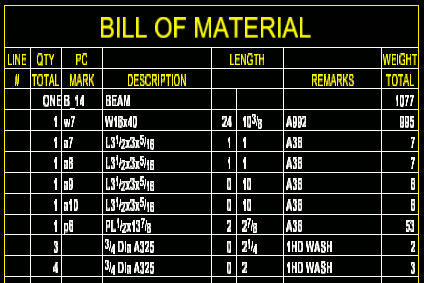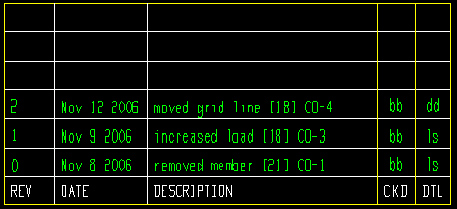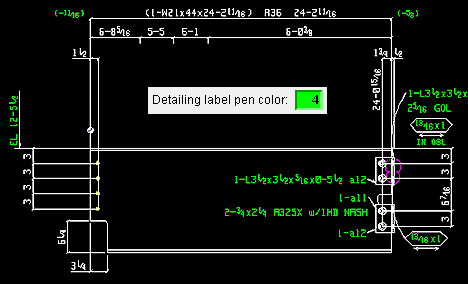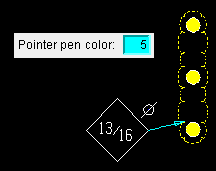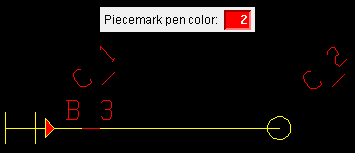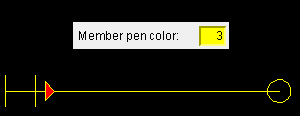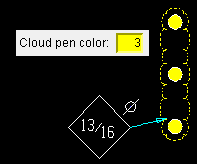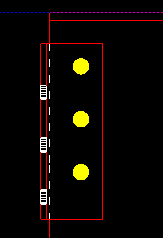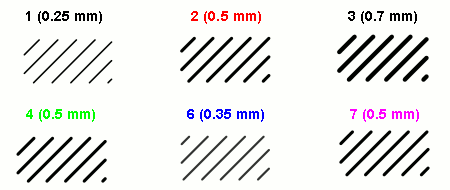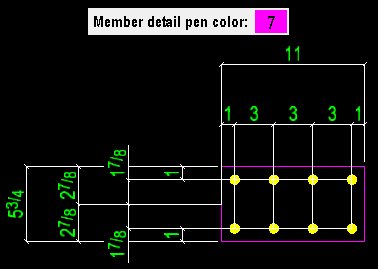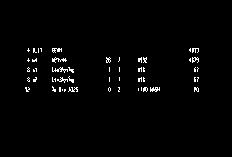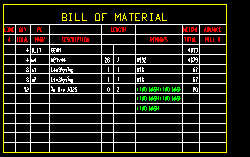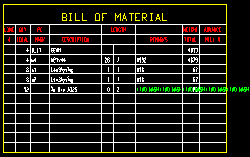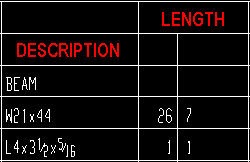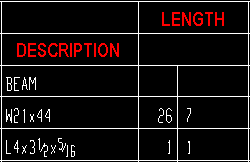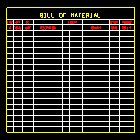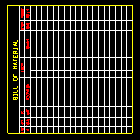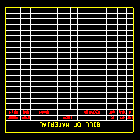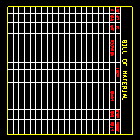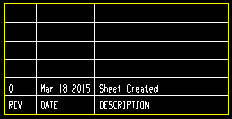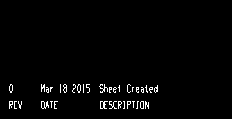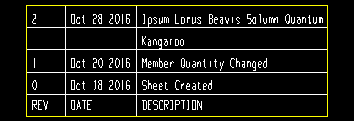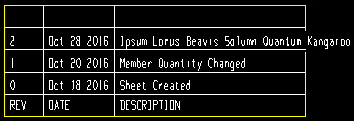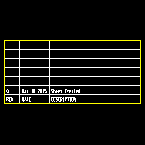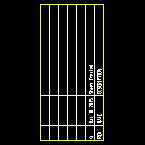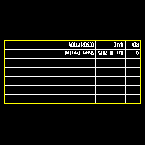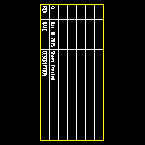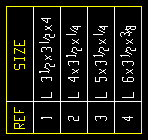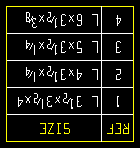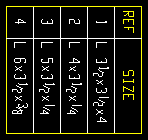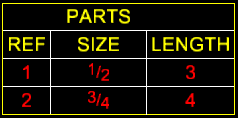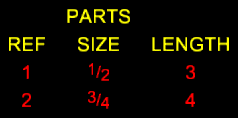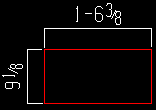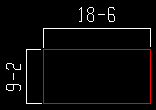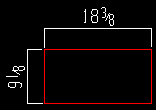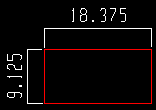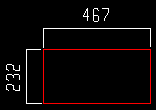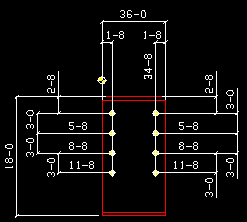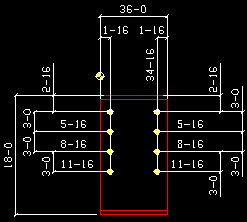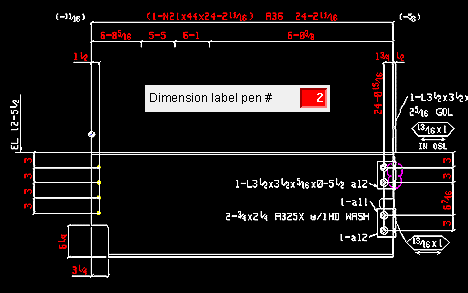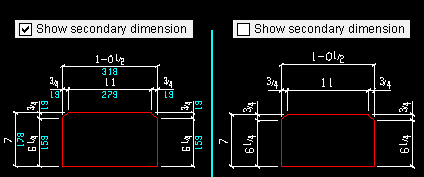The Drawing Presentation setup window ( Fabricator Settings )
- Tabs:
page 1 | contents | home > project settings > fabricator > detailing > | classic
To open Drawing Presentation :
Method 1 : Home > Project Settings > Fabricator > Detailing > Drawing Presentation .
Methods 2, 3 & 4 : In Modeling or the Drawing Editor , choose Settings > Fabricator Settings > Drawing Presentation (classic), or use a keyboard shortcut , or click the icon.
page 1 | contents | home > project settings > fabricator > detailing > | classic | top
| Sizes | Fonts | Pens | Bill of
Material |
Revision
Chart |
Tables | Primary
Dimensions |
Secondary
Dimensions |
Colors |
| These settings apply during the automatic detailing of member details and/or submaterial details and/or erection view drawings. |
Labels character height: The height ( in millimeters ) of the characters that make up labels .
All characters are the same width/height :
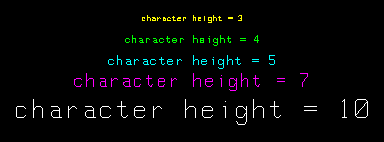
Effect on a full-featured SDS2 program: The number of millimeters shown here applies to labels on details whose piecemarks are selected during automatic detailing of members or submaterial in a full-featured SDS2 program . A character height of 3.5 millimeters is ideal in most cases.
Font dependencies: This applies to whatever font is selected as the " Label font ," regardless of whether that font is a TrueType font or the ' SDS2 ' font.
Also see: This option also sets the default " Label Character Height " on the Edit Palette in the Drawing Editor (accessed using Linetype > Edit Palette ) and the " Character height " on the Edit Label window when Label Add is used immediately after starting the Drawing Editor .
Labels width/height ratio: The width-to-height ratio to be applied to labels .
|
Effect on a full-featured SDS2 program: The ratio shown here applies to details whose piecemarks are selected during automatic detailing of members or submaterial in a full-featured SDS2 program . An entry of ' .5 ' designates characters 1/2 as wide as they are tall and is the default for this field.
Font dependencies: This applies to whatever font is selected as the " Label font ," regardless of whether that font is a TrueType font or the ' SDS2 ' font. For a TrueType font, a ratio of ' 0.6 ' renders that font at its native width. A ratio larger than ' 0.6 ' stretches the font. A ratio less than ' 0.6 ' compacts the font. For the ' SDS2 ' font, ' 0.4 ' is the default choice.
Section size character height: The height ( in millimeters ) that section size lettering will be on erection view drawings when automatic detailing of erection views is done in a full-featured SDS2 program .
|
Font dependencies: This applies to whatever font is selected as the " Member labels font ," regardless of whether that font is a TrueType font or the ' SDS2 ' font.
Section size width/height ratio: The width-to-height ratio that will be applied to section size lettering on erection view drawings when automatic detailing of erection views takes place in a full-featured SDS2 program .
|
Example: An entry of ' .5 ' designates characters 1/2 as wide as they are tall.
Font dependencies: This applies to whatever font is selected as the " Member labels font ," regardless of whether that font is a TrueType font or the ' SDS2 ' font. For a TrueType font, a ratio of ' 0.6 ' renders that font at its native width. A ratio larger than ' 0.6 ' stretches the font. A ratio less than ' 0.6 ' compacts the font. For the ' SDS2 ' font, ' 0.4 ' is the default choice.
Piecemark character height: The height ( in millimeters ) that piecemark lettering will be on erection view drawings when automatic detailing of erection views takes place in a full-featured SDS2 program .
|
Font dependencies: This applies to whatever font is selected as the " Member labels font ," regardless of whether that font is a TrueType font or the ' SDS2 ' font.
Piecemark width/height ratio: The width-to-height ratio that will be applied to piecemarks on erection view drawings that are generated when automatic detailing of erection views takes place in a full-featured SDS2 program .
|
Example: An entry of ' .5 ' designates characters 1/2 as wide as they are tall.
Font dependencies: This applies to whatever font is selected as the " Member labels font ," regardless of whether that font is a TrueType font or the ' SDS2 ' font. For a TrueType font, a ratio of ' 0.6 ' renders that font at its native width. A ratio larger than ' 0.6 ' stretches the font. A ratio less than ' 0.6 ' compacts the font. For the ' SDS2 ' font, ' 0.4 ' is the default choice.
Weld Symbols character height: The weld symbol character height ( in millimeters ) that will be applied to weld symbols that are automatically generated when the automatic detailing of members takes place in a full-featured SDS2 program .
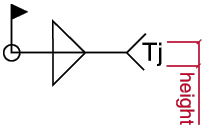
Size of dimension terminals: a number less than 1 or 1 or a number greater than 1 . This sets the size for all dimension terminals in drawings of members, submaterials and erection views that are subsequently generated during auto detailing in a full-featured SDS2 program. It also sets the default size of terminals on dimensions that are subsequently added (using operations such as Objects > Dimensions > Add ) to drawings (of any type) with no dimensions already in them.
|
| A green label indicates each dimension's terminal size. | |||||
|
" Dimension terminals " in set to ' Arrow '. | ||||
|
" Dimension terminals " in set to ' Slash '. | ||||
' A number less than 1 ' reduces the size of dimension terminals relative to a terminal size of 1. For example, a size ' .5 ' terminal is 1/2 the size of a size ' 1 ' terminal. A size ' .75 ' terminal is 3/4 the size of a size ' 1 ' terminal.
' 1 ' is the standard size of dimension terminals. In pre-2018 versions of SDS2 software, all dimension terminals were this size. In 2018 versions and newer, dimension terminals can be scaled on individual dimensions or groups of dimensions using " Size of dimension terminals " on the Edit Dimension window.
' A number greater than 1 ' increases the size of dimension terminals relative to what their size ' 1 ' size would be. For example, a size ' 1.5 ' terminal is 1 1/2 times the size of a size ' 1 ' terminal. A size ' 2 ' terminal is 2 times the size of a size ' 1 ' terminal.
To override the size entered here: : Users can alter dimension terminal sizes on individual dimensions using the " Size of dimension terminals " option on the Edit Dimension window.
Size of pointer arrowheads: a number less than 1 or 1 or a number greater than 1 . This sets the size for all pointer arrowheads in drawings of members, submaterials and erection views that are subsequently generated during auto detailing in a full-featured SDS2 program. It also sets the default size of arrowheads on pointers that are subsequently added (using operations such as Objects > Pointers > Add ) to drawings (of any type) with no pointers already in them.
|
' A number less than 1 ' reduces the size of pointer arrowheads relative to an arrowhead size of ' 1 '. For example, a size ' .5 ' arrowhead is 1/2 the size of a size ' 1 ' arrowhead. A size ' .75 ' arrowhead is 3/4 the size of a size ' 1 ' arrowhead.
' 1 ' is the standard size of an arrowhead. In pre-2018 versions of SDS2 software, all arrowheads were this size. In 2018 versions and newer, arrowheads can be scaled on individual pointers or groups of pointers using " Size of arrowhead " on the Pointer Edit window.
' A number greater than 1 ' increases the size of pointer arrowheads relative to what their size 1 size would be. For example, a size ' 1.5 ' arrowhead is 1 1/2 times the size of a size ' 1 ' arrowhead. A size ' 2 ' arrowhead is 2 times the size of a size ' 1 ' arrowhead.
To override the size entered here: Users can alter individual pointer arrowheads using " Size of arrowhead " on the Pointer Edit window.
Size of workpoint symbols: a number less than 1 or 1 or a number greater than 1 . This sets the size for all workpoint symbols in drawings that are subsequently generated during auto detailig .of members in a full-featured SDS2 program. It also sets the size of workpoints that are subsequently added using operations such as Objects > Workpoint > Add .
|
' A number less than 1 ' reduces the size of workpoint symbols relative to a symbol size of 1. For example, a size ' .5 ' symbol is 1/2 the size of a size 1 symbol. A size ' .75 ' symbol is 3/4 the size of a size ' 1 ' symbol.
' 1 ' is the standard size of workpoint symbol. In pre-2018 versions of SDS2 software, all workpoint symbols were this size, and users could not change the size. In 2018 versions and newer, workpoint symbols can be scaled using " Symbol size " on the Workpoint Edit window.
' A number greater than 1 ' increases the size of workpoint symbols relative to what their size ' 1 ' size would be. For example, a size ' 1.5 ' symbol is 1 1/2 times the size of a size ' 1 ' symbol. A size ' 2 ' symbol is 2 times the size of a size ' 1 ' symbol.
To override the size entered here: : Users can alter individual workpoint symbols using the " Symbol size " option on the Workpoint Edit window.
page 1 | contents | home > project settings > fabricator > detailing > | classic | top
| Sizes | Fonts | Pens | Bill of
Material |
Revision
Chart |
Tables | Primary
Dimensions |
Secondary
Dimensions |
Colors |
Label font: The font for labels that are generated during auto detailing in a full-featured SDS2 program .
|
The color green identifies labels in this example. Labels should not be confused with the text that is a part of bevel symbols , dimensions or weld symbols . |
Label font style: The style (' Bold ' or ' Bold Italic ' or ' Italic ' or ' Regular ') of the selected " Label font ."
Also see: The Edit Label window has " Font " and " Font style " options which can be used to apply different fonts to individual incidences of labels.
Dimension labels font: The font for dimension labels that are generated during auto detailing .
|
The color green identifies dimension labels in this example. |
Dimension labels style: The style (' Bold ' or ' Bold Italic ' or ' Italic ' or ' Regular ') of the selected " Dimension label font ."
Also see: The Dimension Edit and Edit Arc Dimension windows have options for applying a " Font " and " Font style " to the primary dimension label. Similar options are available on these windows for the secondary dimension label .
Symbols font: The font for bevel symbols and weld symbols .
|
|||||
|
Symbols font style: The style (' Bold ' or ' Bold Italic ' or ' Italic ' or ' Regular ') of the selected " Symbols font ."
Also see: The Bevel Symbol and Weld Input windows have " Label font " and " Label font style " options which you can use to apply different fonts to individual incidences of labels.
Member labels font: The font for camber annotations, elevations, ABM page-lines.
|
The member labels in this example are elevations. They are shown in the color green. |
Member labels font style: The style (' Bold ' or ' Bold Italic ' or ' Italic ' or ' Regular ') of the selected " Member labels font ."
Member piecemark labels font: The font for member numbers and member piecemarks .
|
The member piecemark labels in this example are shown in the color green. Member numbers may be set up to be shown along with piecemarks in a full-featured SDS2 program. In this example, only the piecemarks are shown. |
Member piecemark labels font style: The style (' Bold ' or ' Bold Italic ' or ' Italic ' or ' Regular ') of the selected " Member piecemark labels font ."
Member section size labels font: The font for member section sizes .
|
The member section size labels in this example are shown in the color green. |
Member section size labels font style: The style (' Bold ' or ' Bold Italic ' or ' Italic ' or ' Regular ') of the selected " Member section size labels font ."
Bill of material font: Any font that is listed can be selected. This applies to the text that is compiled into the bill when, for example, member details are placed on a sheet in a full-featured SDS2 program . The font that is selected here is the default " Bill font ."
|
|||
| The " Bill of material font " applies to the information compiled into the bill when you Sheet Item Add ( ONE B_14 BEAM . . . ). In this example, the color of the bill data is white. |
Bill of material font style: The style (' Bold ' or ' Bold Italic ' or ' Italic ' or ' Regular ') of the selected " Bill of material font ."
Also see: The Edit Label window has " Label font " and " Label font style " options which users of a fulcan use to apply different fonts to the bill of material itself (to the yellow labels in the above example).
Sheet revision font: The font for entries that are made to any revision chart .
|
|||
| The green-colored text in the revision chart shown above is plotted in the " Sheet revision font " that is selected here, in Drawing Presentation . In this example, the font happens to be the ' SDS2 ' font, which is also the font that the headers ( REV , DATE , etc.) are printed in. The font for those headers is not controlled by the " Sheet revision font ." |
Sheet revision font style: The style (' Bold ' or ' Bold Italic ' or ' Italic ' or ' Regular ') of the selected " Sheet revision font ." Different fonts may have different styles available to them.
page 1 | contents | home > project settings > fabricator > detailing > | classic | top
| Sizes | Fonts | Pens | Bill of
Material |
Revision
Chart |
Tables | Primary
Dimensions |
Secondary
Dimensions |
Colors |
| Line Weights defaults set printers to draw detail sheets using black lines of various widths. For example, pen number 1 (white) is, by default, set to draw a narrow black line. With the exception of " Bill label pen color ," the pen settings shown here apply during auto detailing in a full-featured SDS2 program .. |
Bill label pen color: 1 or 2 or 3 or 4 or 5 or 6 or 7 (see note ).
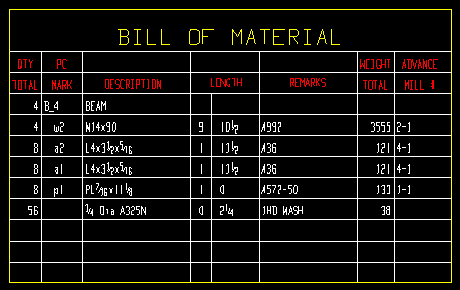
|
| The Bill label pen color applied to the "" bill of material shown in this example is ' 1 ' (white). |
For a TrueType font , this setting affects the display color of that font while you are in the Drawing Editor , but does not in any way affect the plotted appearance of the font.
For the ' SDS2 ' font, the pen number sets the stroke weight (thickness) of the text that is plotted on line 1 and in other lines on a system-generated bill of material. It will also affect the stroke weight of text in a revision chart .
Also see: The " Bill of material font " sets the font that is used for information that is compiled into a bill of material.
Detailing label pen color: 1 or 2 or 3 or 4 or 5 or 6 or 7 (see note ).
|
For a TrueType font , this option affects the display color of that font, but does not in any way affect the plotted appearance of the font.
For the ' SDS2 ' font, the pen number sets the stroke weight (thickness) of the text used for labels .
Pointer pen color: 1 or 2 or 3 or 4 or 5 or 6 or 7 (see note ).
|
Effect on a Site Planning: This pen number also sets the default color of pointers drawn interactively when you Pointer Add .
Effect on a full-featured SDS2 program: The pen number for plotting shown here sets the on-screen display color of pointers generated automatically when automatically detailing of members or submaterials takes place in a full-featured SDS2 program .
Section size pen color: 1 or 2 or 3 or 4 or 5 or 6 or 7 (see note ).
|
Effect on a full-featured SDS2 program: The pen number for plotting shown here sets the on-screen display color of section sizes in Modeling and on section size labels generated during automatic detailing of erection views in a full-featured SDS2 program .
For a TrueType font , this option affects the display color of that font, but does not in any way affect the plotted appearance of the font.
For the ' SDS2 ' font, the pen number sets the stroke weight (thickness) of the section size text when it is plotted. The stroke weight of the font as it is shown in the Drawing Editor is not affected by the pen number.
Piecemark pen color: 1 or 2 or 3 or 4 or 5 or 6 or 7 (see note ).
|
Effect on a full-featured SDS2 program: The pen number for plotting shown here sets the on-screen display color of piecemarks in Modeling views and the color of piecemark labels generated during automatic detailing of erection views in a full-featured SDS2 program .
For a TrueType font , this option affects the display color of that font, but does not in any way affect the plotted appearance of the font.
For the ' SDS2 ' font, the pen number sets the stroke weight (thickness) of the piecemark text when it is plotted. The stroke weight of the font as it is shown in the Drawing Editor is not affected by the pen number.
Member pen color: 1 or 2 or 3 or 4 or 5 or 6 or 7 (see note ).
|
Effect on a full-featured SDS2 program: The pen number for plotting shown here sets the on-screen display color of members displayed in stick form in Modeling and on erection view drawings that are generated during automatic detailing of erection views in a full-featured SDS2 program .
Cloud pen color: 1 or 2 or 3 or 4 or 5 or 6 or 7 (see note ).
|
Effect on a full-featured SDS2 program: The pen number for plotting shown here sets the on-screen display color of clouds generated automatically when automatic detailing of members or submaterial takes place in a full-featured SDS2 program .
Weld pen color: 1 or 2 or 3 or 4 or 5 or 6 or 7 (see note ).
|
A weld symbol that is drawn with pen ' 1 ' (white). |
Effect on a full-featured SDS2 program: The pen number for plotting shown here sets the on-screen display color of weld symbols generated when automatic detailing of members takes place in a full-featured SDS2 program .
Tail text: If you are using the 'SDS2 ' font , this also affects the printed thickness (though not the Drawing Editor's displayed thickness) of that font. The font that is applied to weld symbol tail text during automatic detailing is the " Symbols font ."
Dimension pen color: 1 or 2 or 3 or 4 or 5 or 6 or 7 (see note ).
Effect on a full-featured SDS2 program: The pen number for plotting shown here sets the on-screen display color of dimension lines and legs generated automatically when automatic detailing of members or submaterial takes place in a full-featured SDS2 program .
Bevel pen color: 1 or 2 or 3 or 4 or 5 or 6 or 7 (see note ).
|
A bevel symbol that is drawn with pen ' 1 ' (white). |
Effect on a full-featured SDS2 program: The pen number for plotting shown here sets the on-screen display color of bevel symbols generated automatically when automatic detailing of members or submaterial takes place in a full-featured SDS2 program .
Bevel text: If you are using the 'SDS2 ' font , this also affects the printed thickness (though not the Drawing Editor's displayed thickness) of that font. The font applied to bevel symbol text during automatic detailing is the " Symbols font ."
Grid line/bubble pen color: White or red or Yellow or Green or Cyan or Blue or Magenta . This option sets the default display color for each new grid line that is added in a full-featured SDS2 program .
|
|
|
|
| In Modeling , the choice made here sets the default display color of the grid line and grid bubble (if there is one), but not the color of the text that is the grid line's name. |
For straight grid lines , the choice made here only affects the display color of the grid line. Straight grid lines appear in Modeling only. Straight grid lines cannot be made to appear on erection view drawings. They can be dimensioned on erection view drawings, but do not actually appear as objects on those drawings.
For curved grid lines , the choice made here may also affect the Drawing Editor pen number that is applied to the grid line when an erection view drawing shows the curved grid line. The pen number that is applied to a curved grid line will directly affect the plotted line thickness of that curved grid line when it is plotted. Line Weights sets the thickness of lines drawn for each of the seven pen numbers that can be applied to graphic objects (lines, arcs, etc.) in the Drawing Editor .
Also see: In the Drawing Editor , curved grid lines on erection view drawings are arcs, the " Pen color " of which can be reviewed on the Arc Edit window.
Filled hole pen color : 1 or 2 or 3 or 4 or 5 or 6 or 7 (see note ). This sets the display color for flat holes in the Drawing Editor . Line Weights defaults set all pen numbers to black.This option does not set the pen number for plotting holes -- it sets their Drawing Editor display color only. Pen ' 0 ' is the Line Weights pen for plotting filled holes.
|
Only holes that are shown as flat (in the same plane as the surface they are on) are filled with the " Filled hole pen color ." |
User-added holes: Holes that are added manually in the Drawing Editor using Hole Add will be filled with this color if they they are flat. A user-added flat hole is placed by locating the same point twice. Side views of holes, which are added by locating two different points are not filled.
Holes on erection views that were detailed with the " Member style " set to ' Wire ' or ' Stick + wire ' are filled with the " Filled hole pen color " that is selected here.
For member and submateterial details, holes that are shown as flat are filled with the " Filled hole pen color ."
Hatch pen color: 1 or 2 or 3 or 4 or 5 or 6 or 7 (see note ). This sets the pen (color) that, by default, is selected as the " Hatch pen color " for the first hatch that is added during a Drawing Editor session. Hatches subsequently added during that same session will, by default, be assigned the " Hatch pen color " of the last-added hatch.
The choice made to " Hatch pen color " (in the Drawing Editor ) sets the thickness of the lines that make up the hatch pattern. It also sets the hatch's on-screen display color. The actual color of the hatch pattern, when printed, is defined in Line Weights . By default, all drawing pens are defined to be the color black.
|
Same hatch pattern, six different pen numbers . The pen width (mm) for each pen number is written in parentheses. The pen widths are assigned to pen numbers in Line Weights . |
Member detail pen color: 1 or 2 or 3 or 4 or 5 or 6 or 7 (see note ).
|
The " Member detail pen color " applies to submaterial details as well as member details. A submaterial detail is shown in this example. |
Effect on detailing and printing: This sets the default " Pen color " for polygon sides during automatic detailing of members or submaterials in a full-featured SDS2 program. During printing of a sumaterial or member detail, the pen number sets the line thickness of material polygons that are represented on the drawing.
page 1 | contents | home > project settings > fabricator > detailing > | classic | top
| Sizes | Fonts | Pens |
Bill of
Material |
Revision
Chart |
Tables | Primary
Dimensions |
Secondary
Dimensions |
Colors |
Spaces between fields in the bill of material: One or Two . The selection shown here applies (in a full-featured SDS2 program ) when Place Bill is used to create a bill of materiall on a sheet outline.
If ' One ' is selected, then one space will separate columns in a bill of material that has been plotted .
If ' Two ' is selected, then two spaces will separate columns on the plotted bill of material.
Bill items character height: The character height ( millimeters ) of items listed on a plotted bill of material. This applies (in a full-featured SDS2 program ) when Place Bill is used to create a bill of material on a sheet outline. You can see the results of the entry shown here when the bill of material has been plotted . This applies to whatever font is selected as the " Bill of material font ," regardless of whether that font is a TrueType font or the ' SDS2 ' font.
Bill items width/height ratio: The width-to-height ratio to be applied to items listed in the bill of material. This applies (in a full-featured SDS2 program ) when Place Bill is used to create a bill of material on a sheet outline. You can see the results of the entry shown here when the bill of material has been plotted .
|
Example: An entry of ' .333 ' sets characters to be 1/3 as wide as they are tall. This applies to whatever font is selected as the " Bill of material font ," regardless of whether that font is a TrueType font or the ' SDS2 ' font.
Show grid: ![]() or
or ![]() . This applies to bills of material that are subsequently placed in a full-featured SDS2 program .
. This applies to bills of material that are subsequently placed in a full-featured SDS2 program .
|
If this box is checked (
), the bill of material's interior lines, header text and title text will be shown.
If the box is not checked (
), the bill's interior lines, header text and title text will not be shown.
Overriding the choice made here: After a bill of material has been placed, users of a full-featured SDS2 program can double-click that bill to open that bill's edit window and change the choice made for " Show grid ."
Wrap fields to next line: ![]() or
or ![]() . This applies when, in a full-featured SDS2 program , more characters have been entered to a cell than that cell has room for.
. This applies when, in a full-featured SDS2 program , more characters have been entered to a cell than that cell has room for.
|
|||||
| In this example, too much text ( shown in green ) was added to the " Remarks " column for a particular piece of material. |
If this box is checked (
), the text will wrap to the next line. If a new line needs to be created, then one will be created so that the text does not overwrite text in other cells.
If the box is not checked (
), the text will spill over to the next cell to the right, overwriting text in that cell. If there is no next cell, the text will spill outside of the bill.
Overriding the choice made here: On a bill of material that has been placed, users of a full-featured SDS2 program can double-click that bill to open the bill's edit window and change the choice made for " Wrap to next line ."
Extend foot/inch separator: ![]() or
or ![]() . This applies when a " Length " column is included in the bill of material and the primary dimension " Units " is set to 'I mperial (feet-in frac) '. This sets the default choice made for " Extend foot/inch separator " that is applied when a bill is placed in a full-featured SDS2 program .
. This applies when a " Length " column is included in the bill of material and the primary dimension " Units " is set to 'I mperial (feet-in frac) '. This sets the default choice made for " Extend foot/inch separator " that is applied when a bill is placed in a full-featured SDS2 program .
|
|||||
| To see the difference, look at the second row of the " Length " column. |
If this box is checked (
), the line that is the foot/inch separator is extended through the second row of the " Length " column.
If the box is not checked (
), the line that is the foot/inch separator terminates below the second row of the " Length " column.
Rotation: 0º or 90º or 180º or -90º . Rotation is counterclockwise around what, for a 0 degree rotation, would be the upper, right corner of the bill. This sets the default " Rotation " that will be applied when a bill is placed in a full-featured SDS2 program .
|
Overriding the choice made here: The " Rotation " of an individual bill of material can be changed on the edit window for that bill in a full-featured SDS2 program .
Outside pen color: 1 or 2 or 3 or 4 or 5 or 6 or 7 . This sets the default " Outside pen color " that will be applied to bills of material that are subsequently placed in a full-featured SDS2 program .
|
|
| The selected button sets the drawing pen and on-screen display color of the bill of material's perimeter. Line Weights sets the thickness of lines that are printed using a particular drawing pen. |
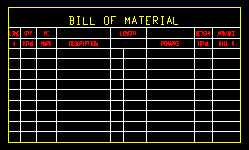
|
The outside pen color sets the display color and plotted line thickness of the bill's perimeter. In this example, the color is yellow (pen ' 3 '). |
Overriding the choice made here: Users of a full-featured SDS2 program can enter a different " Outside pen color " on the edit window that opens when they double-click that bill.
Inside pen color: 1 or 2 or 3 or 4 or 5 or 6 or 7 . This sets the default " Inside pen color " that will be applied to bills of material that are subsequently placed in a full-featured SDS2 program .
|
|
| The selected button sets the drawing pen and on-screen display color of the bill of material's interior grid of lines. Line Weights sets the printing thickness of printed lines for each of the seven drawing pens. |

|
The inside pen color sets the display color and the plotted line thickness for the bill's inner grid. In this example, the color is white (pen ' 1 '). |
Overriding the choice made here: The " Inside pen color " of an individual bill of material can be changed a full-featured SDS2 program on that bill's Bill of Material Layout setup override window.
Maximum spacing between items: A number of blank rows . This applies when bill data for more than one member is included in a bill of material. If there isn't enough room to apply the maximum number of blank rows, the program may reduce the number of blank rows to as few as one row. The number entered here sets the default " Maximum spacing between items " that will be applied to bills of material that are subsequently placed in a full-featured SDS2 program .
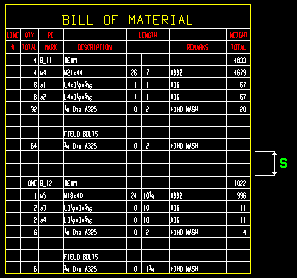
|
s = spacing. In this example, the spacing is two rows. The two rows separate the bill data for member B_11 from the bill data for member B_12. |
Overriding the choice made here: The " Maximum spacing between items " can be changed on the edit window for an individual bill of material.
Minimum number of rows: The number of rows that will be shown when the bill of material has no bill data compiled into it. When users in a full-featured SDS2 program add new bill data, the number of lines will increase beyond this minimum if doing so is required to accommodate the added data and if the " Maximum number of rows " is set to a larger number than the minimum.
|
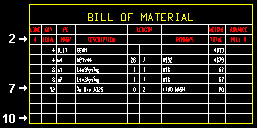
|
In this example, the headers take up 2 rows, the bill data takes up 5 rows, and the " Minimum number of rows " is ' 10 '. This leaves 3 blank rows. |
Overriding the choice made here: The above setting applies when a new bill is created in a full-featured SDS2 program . Once that bill is placed, it's " Minimum number of rows " can be changed on the bill edit window in that same program.
Maximum number of rows: The number of rows that a bill of material is allowed to dynamically expand to in order to accommodate new bill data that can be added by users of a full-featured SDS2 program . This sets the default " Maximum number of rows " that will be applied to new bills of material subsequently placed in a full-featured SDS2 program .
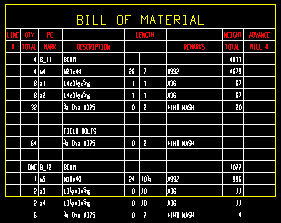
|
In this example, the bill data spills out past the bottom edge of the bill. To fix this problem, a user of a full-featured SDS2 program could double-click the bill of material then increase the " Maximum number of rows " on that bill of material's edit window. |
Title text: The characters in the bill of material's title. This sets the default " Title text " that will be applied to new bills of material subsequently placed in a full-featured SDS2 program .
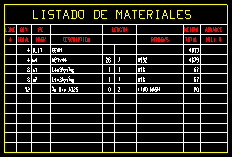
|
The " Title text " in this example is " LISTADO DE MATERIALES ." |
Overriding the choice made here: The above setting applies to bills of material that have not yet been placed. Users in a full-featured SDS2 program can change a placed bill's " Title text " on the edit window that opens when they double-click that bill of material.
Title character width/height ratio: The width/height of the characters that make up the title text in the bill of material. This sets the default " Title character width/height ratio " that will be applied to new bills of material subsequently placed in a full-featured SDS2 program .
|
Font dependencies: This applies to whatever font is selected as the " Title font ," regardless of whether that font is a TrueType font or the ' SDS2 ' font. For a TrueType font, a ratio of ' 0.6 ' renders that font at its native width. A ratio larger than ' 0.6 ' stretches the font. A ratio less than ' 0.6 ' compacts the font. For the ' SDS2 ' font, ' 0.4 ' is the default choice.
Title font: The font that is selected applies to the title text, not to the header text or bill data text. This sets the default " Title font " that will be applied to new bills of material subsequently placed in a full-featured SDS2 program .
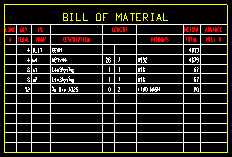
|
The " Title font " applies to the bill title ( BILL OF MATERIAL ). |
Also see: The " Title font style " applies to this font.
Title font style: The style (' Bold ' or ' Bold Italic ' or ' Italic ' or ' Regular ') applied to the selected " Title font ." Different fonts may have different styles available to them. This sets the default " Title font style " that will be applied to new bills of material subsequently placed in a full-featured SDS2 program .
Header font: The font for bill of material headers. This sets the default " Header font " that is applied to that are placed in a full-featured SDS2 program . The " Header font style " applies to this font.
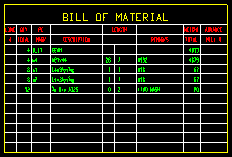
|
Headers in this example of a bill of material are displayed in the color red ( LINE # , PC MARK , Description , etc .) |
Bill of material headers are named in Bill of Material Layout ( Fabricator Setup ) when users of a full-featured SDS2 program make entries to the " Header line 1 " and " Header line 2 " columns on that setup window. The " Header font " is applied to headers when a bill of material is created in the Drawing Editor . Typically, bills of material are placed on sheet outlines.
Header font style: The style (' Bold ' or ' Bold Italic ' or ' Italic ' or ' Regular ') of the selected " Header font ." Different fonts may have different styles available to them. This sets the default " Header font style " that will be applied to new bills of material subsequently placed by users in a full-featured SDS2 program .
page 1 | contents | home > project settings > fabricator > detailing > | classic | top
| Sizes | Fonts | Pens | Bill of
Material |
Revision
Chart |
Tables | Primary
Dimensions |
Secondary
Dimensions |
Colors |
| Additional setup options related to revision chart s can be found on the Sheet Revisions setup window. Also see " Sheet revision font " under the " Fonts " tab. |
Show grid: ![]() or
or ![]() . This sets the default choice made to " Show grid " when a new revision chart is added in a full-featured SDS2 program .
. This sets the default choice made to " Show grid " when a new revision chart is added in a full-featured SDS2 program .
|
If this box is checked (
), the perimeter lines and interior lines and column text and revision line text will be shown on newly placed revision charts.
If the box is not checked (
), only the revision line text and column text will be shown. The interior lines and perimeter lines will not be shown.
Overriding the choice made here: In a full-featured SDS2 program , " Show grid " can be changed on the edit window for an individual revision chart .
Wrap fields to next line: ![]() or
or ![]() . This sets the default choice made in the Drawing Editor to " Wrap fields to next line " when a new revision chart is added in a full-featured SDS2 program . The choice made in the Drawing Editor to " Wrap fields to next line " applies when a revision chart has more characters entered to a cell than that cell has room for.
. This sets the default choice made in the Drawing Editor to " Wrap fields to next line " when a new revision chart is added in a full-featured SDS2 program . The choice made in the Drawing Editor to " Wrap fields to next line " applies when a revision chart has more characters entered to a cell than that cell has room for.
|
|||||
| In both of these examples, the revision 2 " Description " is too long to fit in a single cell. |
If this box is checked (
) for a newly placed revision chart, text that is too long to fit in a sngle cell will wrap to the next line. A new line will be created, if needed, so that the text does not overwrite text in the adjacent cell.
If the box is not checked (
), text that is too long to fit in its cell will spill over to the next cell to the right, overwriting text in that cell. If there is no next cell, the text will spill outside of the revision chart.
Number of lines: The number of lines (rows) that will be shown when the revision chart is first placed onto a sheet or sheet outline in a full-featured SDS2 program .
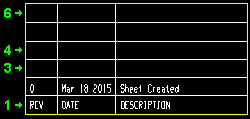
|
The number of lines in this revision chart is ' 6 '. |
Overriding the choice made here: In a full-featured SDS2 program , users can change the " Number of lines " on the edit window for an individual revision chart. Also, if the number of lines entered to the Sheet Revision Chart Editor is greater than the available number of lines in the revisions chart, new lines will automatically be added to the revision chart so that it can accommodate the new information.
Header position: ![]() Top or
Top or ![]() Bottom . This sets the default choice made in the Drawing Editor to " Header postion " when a revision chart is first placed onto a sheet or sheet outline in a full-featured SDS2 program .
Bottom . This sets the default choice made in the Drawing Editor to " Header postion " when a revision chart is first placed onto a sheet or sheet outline in a full-featured SDS2 program .
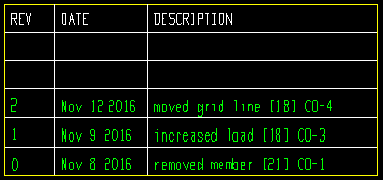
|
For this example, " Header position " is set to ' Top '. " Order of revision lines " is set to ' Bottom to top '. |
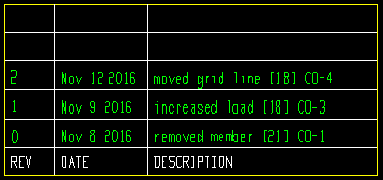
|
For this example, " Header position " is set to ' Bottom '. " Order of revision lines " is set to ' Bottom to top '. |
'
Top ' when selected for an individual Drawing Editor revision chart places the header line text for that chart in cells at the top of the revision chart.
'
Bottom ' when selected for an individual Drawing Editor revision chart places the header line text for that chart in cells at the bottom of the revision chart.
What is top? When the revision chart's " Rotation " is set to ' 0 ', the top of a revision chart is the actual top of the revision chart.
Order of revision lines: ![]() Top to bottom or
Top to bottom or ![]() Bottom to top . This sets the default choice made in the Drawing Editor to " Order of revision lines " when a revision chart is first placed onto a sheet or sheet outline in a full-featured SDS2 program .
Bottom to top . This sets the default choice made in the Drawing Editor to " Order of revision lines " when a revision chart is first placed onto a sheet or sheet outline in a full-featured SDS2 program .
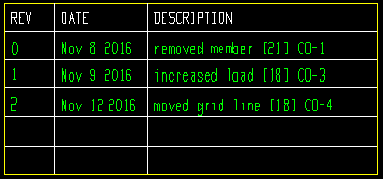
|
For this example, " Order of revision lines " is set to ' Top to bottom '. " Header position " is set to ' Top '. |

|
For this example, " Order of revision lines " is set to ' Bottom to top '. " Header position " is set to ' Top '. |
'
Top to bottom ' when selected for an individual Drawing Editor revision chart displays revision lines from the top of the chart to the bottom of the chart, with the most recent revision being at the bottom.
'
Bottom to top ' when selected for an individual Drawing Editor revision chart displays revision lines from the bottom of the chart to the top of the chart, with the most recent revision being at the top.
What is top? When the revision chart's " Rotation " is set to ' 0 ', the top of a revision chart is the actual top of the revision chart.
Rotation: 0º or 90º or 180º or -90º . Rotation is counterclockwise around the " Anchor location " of the revision chart.
|
||||||||||||
Overriding the choice made here: In a full-featured SDS2 program , " Rotation " can be changed on the edit window for an individual revision chart .
Anchor location: Upper left or Upper right or Lower left or Lower right . This sets the location of the insertion point used when a revision chart is first placed onto a sheet or sheet outline in a full-featured SDS2 program .
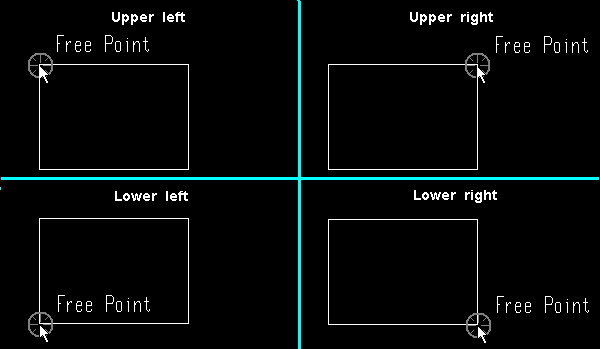
|
| This illustration shows different insertion points being used for placing a revision chart in a full-featured SDS2 program. |
' Upper left ' sets the insertion point at the revision chart's upper, left corner.
' Upper right ' sets the insertion point at the revision chart's upper, right corner.
' Lower left ' sets the insertion point at the revision chart's lower, left corner.
' Lower right ' sets the insertion point at the revision chart's lower, right corner.
After a revision chart has been placed, the " Anchor location " of that already placed revision chart can be changed in a full-featured SDS2 program .
Character height: The character height (in millimeters) of all text in the revision chart . This applies to both the revision line text (" Sheet revision font ") and the column title text (" Column title font ").
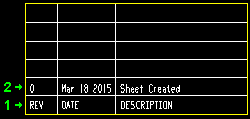
|
Line 2 is revision line text. Line 1 is the column title text. |
Font dependencies: This applies to whatever fonts are selected as the " Column title font " and the " Sheet revision font ," regardless of whether those fonts are TrueType fonts or the ' SDS2 ' font.
Overriding the choice made here: In a full-featured SDS2 program , the " Character height " can be changed on the edit window for an individual revision chart.
Character width/height ratio: The width/height of the characters that make up the text in revision charts that are subsequently placed in a full-featured SDS2 program . This applies to both the revision line text (" Sheet revision font ") and the column title text (" Column title font ").

|
Line 2 is revision line text. Line 1 is the column title text. |
Font dependencies: This applies to whatever fonts are selected as the " Column title font " and the " Sheet revision font ," regardless of whether those fonts are TrueType fonts or the ' SDS2 ' font. For a TrueType font, a ratio of ' 0.6 ' renders that font at its native width. A ratio larger than ' 0.6 ' stretches the font. A ratio less than ' 0.6 ' compacts the font. For the ' SDS2 ' font, ' 0.4 ' is the default choice.
Overriding the choice made here: In a full-featured SDS2 program , the " Character width/height ratio " can be changed on the edit window for an individual revision chart.
Column title font: The font that is selected applies to the column title text, not to revision line text. This sets the default " Column title font " that will be applied to new revision charts subsequently placed in a full-featured SDS2 program .
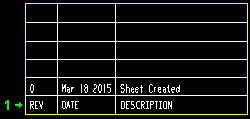
|
Line 1 is the column title text, to which the " Column title font " applies. |
Also see: The " Column title font style " applies to this font.
Overriding the choice made here: The " Column title font " can be changed on the edit window for an individual revision chart.
Column title font style: The style (' Bold ' or ' Bold Italic ' or ' Italic ' or ' Regular ') of the selected " Column title font ." Different fonts may have different styles available to them. This sets the default " Column title font style " that will be applied to new revision charts subsequently placed in a full-featured SDS2 program .

|
Line 1 is the column title text, to which the " Column title font style " applies. |
Available font styles are listed alphabetically in the font style list box , and the first style that is listed when you change to a different " Column title font " is automatically selected as the style for that font. You may, instead of using the automatically selected font style, prefer to choose ' Regular ', which is generally the most popular style for a particular font. ' Regular ' is the only choice that is available for the ' SDS2 ' font. To adjust the stroke thickness of the ' SDS2 ' font, you can change the " Bill label pen color " under the " Pens " tab.
Overriding the choice made here: The above setting applies to revision charts that have not yet been placed. For a revision chart that has already been placed, users in a full-featured SDS2 program can change it's " Column title font style " on the edit window that opens when they double-click that revision chart.
Outside pen color: 1 or 2 or 3 or 4 or 5 or 6 or 7 . This sets the default " Outside pen color " that will be applied to new revision charts subsequently placed in a full-featured SDS2 program .
|
|
| The selected button sets the drawing pen and on-screen display color of the revision chart's perimeter. Line Weights sets the thickness of lines that are printed using a particular drawing pen. |
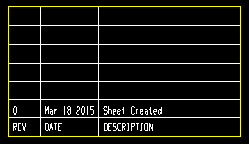
|
The " Outside pen color " sets the color and line thickness of the revision chart's perimeter. In this example, the color is yellow (pen ' 3 '). |
Overriding the choice made here: In a full-featured SDS2 program , users can override this setup choice on an individual revision chart by entering a different " Outside pen color " on the edit window that opens when they double-click that revision chart.
Inside pen color: 1 or 2 or 3 or 4 or 5 or 6 or 7 . This sets the default " Inside pen color " that will be applied to new revision charts subsequently placed in a full-featured SDS2 program .
|
|
| The selected button sets the drawing pen and on-screen display color of the revision chart's perimeter. Line Weights sets the thickness of lines that are printed using a particular drawing pen. |

|
The " Inside pen color " sets the color and the line thickness for the revision chart's inner grid. In this example, the color is white (pen ' 1 '). |
Overriding the choice made here: In a full-featured SDS2 program , users can override this setup choice on an individual revision chart by entering a different " Inside pen color " on the edit window that opens when they double-click that revision chart.
page 1 | contents | home > project settings > fabricator > detailing > | classic | top
| Sizes |
Fonts |
Pens | Bill of
Material |
Revision
Chart |
Tables | Primary
Dimensions |
Secondary
Dimensions |
Colors |
Outside pen color: 1 or 2 or 3 or 4 or 5 or 6 or 7 . When a user of a full-featured SDS2 program places a table in the Drawing Editor , the choice shown here is the default pen that is selected for " Outside pen color " on the Table Edit window
|
|
| The selected pen sets the on-screen display color of the table's perimeter. Line Weights sets the thickness of lines drawn with that pen. |
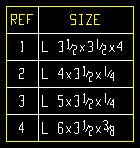
|
The " Outside pen color " sets the color and line thickness of the table's perimeter. In this example, the color is yellow (pen number ' 3 '). |
Inside pen color: 1 or 2 or 3 or 4 or 5 or 6 or 7 . When a user of a full-featured SDS2 program places a table in the Drawing Editor , the choice shown here is the default pen that is selected for " Inside pen color " on the Table Edit window
|
|
| The selected pen sets the on-screen display color of the table's interior grid of lines. Line Weights sets the thickness of lines drawn with that pen. |

|
The " Inside pen color " sets the color and line thickness of the table's inner grid. In this example, the color is white (pen number ' 1 '). |
Rotation: 0º or 90º or 180º or -90º . When a user of a full-featured SDS2 program places a table in the Drawing Editor , the choice shown here is the default " Rotation " on the Table Edit window
|
Rotation is counterclockwise around the " Anchor location ." For the above exampels, the " Anchor location " is set to ' Upper left '.
Anchor location: Upper left or Upper right or Lower left or Lower right . When a user of a full-featured SDS2 program places a table in the Drawing Editor , the choice shown here is the default " Anchor location " on the Table Edit window.
|
|
'
Upper left ' is the upper, left corner of the table when the " Rotation " is set to '0º'.
'
Upper right ' is the upper, right corner of the table when the " Rotation " is set to '0º'.
'
Lower left ' is the lower, left corner of the table when the " Rotation " is set to '0º'.
'
Lower right ' is the lower, right corner of the table when the " Rotation " is set to '0º'.
Show grid: ![]() or
or ![]() . When a user of a full-featured SDS2 program places a table in the Drawing Editor , the choice shown here is the default choice that is made to " Show grid " on the Table Edit window
. When a user of a full-featured SDS2 program places a table in the Drawing Editor , the choice shown here is the default choice that is made to " Show grid " on the Table Edit window
|
If this box is checked (
), the table's lines will be shown.
If the box is not checked (
), only the bill's header text and body text will be shown.
------ Header ------
Font: When a user of a full-featured SDS2 program places a table in the Drawing Editor , the choice shown here is the default header " Font " on the Table Edit window.
|
For a TrueType font , such as any of those shown here, set the header-text " Character width/height ratio " to ' 0.6 ' to have the font rendered at its native width. |
Font style: The style (' Bold ' or ' Bold Italic ' or ' Italic ' or ' Regular ') of the selected header-text " Font ." When a user of a full-featured SDS2 program places a table in the Drawing Editor , the choice shown here is the default header " Font style " on the Table Edit window.
Justification: Left or Center or Right . When a user of a full-featured SDS2 program places a table in the Drawing Editor , the choice shown here is the default header " Justification " on the Table Edit window.
|
'
Left ' left-justifies the header text in each of the header cells.
'
Center ' centers the header text in each of the header cells.
'
Right ' right-justifies the header text in each of the header cells.
Character height: When a user of a full-featured SDS2 program places a table in the Drawing Editor , the choice shown here is the default choice that is made to the header " Character height " on the Table Edit window.
|
Font dependencies: This applies to whatever font is selected as the header-text " Font ," regardless of whether that font is a TrueType font or the ' SDS2 ' font.
Character width/height ratio: The width/height of the characters that make up the label. When a user of a full-featured SDS2 program places a table in the Drawing Editor , the choice shown here is the default header text " Character width/height ratio " on the Table Edit window.
|
Tip: ' 0.6 ' is the optimal choice for a TrueType font. For the ' SDS2 ' font, ' 0.4 ' is a good choice.
Pen color: 1 or 2 or 3 or 4 or 5 or 6 or 7 . When a user of a full-featured SDS2 program places a table in the Drawing Editor , the choice shown here is the default header text " Pen color " on the Table Edit window.
|
|
For a TrueType header-text font, the " Pen color " affects the display color of the header text, but does not affect the plotted appearance of the" Font " so long as all pens in Line Weights are set to print in black. By default, all pens in Line Weights are set to print in black.
For the ' SDS2 ' Font, the pen color sets the stroke weight (thickness) of the label characters. Line Weights assigns a particular thickness to each " Pen color ."
------ Body ------
Font: When a user of a full-featured SDS2 program places a table in the Drawing Editor , the choice shown here is the default body-text " Font " on the Table Edit window.
|
For a TrueType font , such as any of those shown here, set the body-text " Character width/height ratio " to ' 0.6 ' to have the font rendered at its native width. |
Font style: When a user of a full-featured SDS2 program places a table in the Drawing Editor , the choice shown here is the default body-text " Font style " on the Table Edit window.
Justification: Left or Center or Right . When a user of a full-featured SDS2 program places a table in the Drawing Editor , the choice shown here is the default body-text " Justification " on the Table Edit window.
|
'
Left ' left-justifies the text in each of the body cells.
'
Center ' centers the text in each of the body cells.
'
Right ' right-justifies the text in each of the body cells.
Character height: The height (in millimeters) of letters/numbers that make up the body text. When a user of a full-featured SDS2 program places a table in the Drawing Editor , the choice shown here is the default body-text " Character height " on the Table Edit window.
|
Font dependencies: This applies to whatever font is selected as the body-text " Font ," regardless of whether that font is a TrueType font or the ' SDS2 ' font.
Character width/height ratio: The width/height of the characters that make up the body text. When a user of a full-featured SDS2 program places a table in the Drawing Editor , the choice shown here is the default body-text " Character width-height ratio " on the Table Edit window.
|
Font dependencies: For a TrueType font, a ratio of ' 0.6 ' renders that font at its native width. A ratio larger than ' 0.6 ' stretches the font. A ratio less than ' 0.6 ' compacts the font. For the ' SDS2 ' font, ' 0.4 ' is the default choice.
Pen color: 1 or 2 or 3 or 4 or 5 or 6 or 7 . When a user of a full-featured SDS2 program places a table in the Drawing Editor , the choice shown here is the default body-text " Pen color " on the Table Edit window.
|
|
For a TrueType body-text font, the " Pen color " affects the display color of the body text, but does not affect the plotted appearance of the " Font " so long as all pens in Line Weights are set to print in black. By default, all pens in Line Weights are set to print in black.
For the ' SDS2 ' Font, the pen color sets the stroke weight (thickness) of the label characters. Line Weights assigns a particular thickness to each " Pen color ."
page 1 | contents | home > project settings > fabricator > detailing > | classic | top
| Sizes | Fonts | Pens | Bill of
Material |
Revision
Chart |
Tables |
Primary
Dimensions |
Secondary
Dimensions |
Colors |
|
Units: Imperial (feet-in frac) or Imperial (inches-sixteenths) or Imperial (inches fraction) or Imperial (inches decimal) or Metric (mm) . The selection shown here affects Process and Create Solids and auto detailing . It also sets the units that you must use when entering distances . On details with dual dimensioning, the choice shown here affects primary dimensions only (see " Display secondary dimensions ").
|
|
' Imperial( ft-in frac) ' causes distance measurements throughout your current Job to be in feet and inches. You may then enter dimensions using a dash (e.g. 10-6 means ten feet, six inches) and by placing a space between inches and fractions of an inch (e.g. 2 1/2 signifies two-and-a-half inches). Weights of materials are in pounds; loads are in kips; tonnages are in tons (2,000 lbs). Also see note .
' Imperial (inches-sixteenths) ' sets distance measurements to be expressed in inches and fractions of an inch with a dash separating the units (e.g. two feet and a half inch would be expressed as 24-8 ). See entering distances . Weights of materials are in pounds; loads are in kips; tonnages are in tons (2,000 lbs). Also see note .
' Imperial (inches fraction) ' sets distance measurements to be expressed in inches and fractions of an inch (e.g. two feet and a half inch would be expressed as 24 1/2 ). Weights of materials are in pounds; loads are in kips; tonnages are in tons (2,000 lbs).
' Imperial (inches decimals) ' sets distance measurements to be expressed in decimal inches (e.g. two feet and one-half inch is 24.5 ). Weights of materials are in pounds; loads are in kips; tonnages are in tons (2,000 lbs).
' Metric ' expresses distance measurements in millimeters. You cannot use dashes to write metric distances. Metric weights of materials are in kilograms; loads are in kilonewtons; tonnages are in metric tons (1,000 kg).
Note: If the units are not shown in a dimension field, the reported distance is in the primary dimension " Units " that are set here. That reported distance is a multiple of the " Dimension precision ." Units other than the pirmary dimension units may be shown in a dimension field when "
Lock primary units " is turned off (not checked)."
In the following example, the " Units " are ' Imperial (ft-in frac) ', and the entered value and stored value are the same in each case. The displayed value changes when " Lock primary units " is turned on or off.
Lock ...
Lock ...
Entered value: 

Stored value: 

Displayed value: 

If this box is checked (
), the units in entry fields and on system-generated labels and primary dimension labels on drawings will be displayed only in the primary dimension " Units ." You can still enter a distance in other units , which will affect its stored value (in inches), but its displayed value will always be rounded to the dimension precision set for the primary dimension " Units ." An exception to this is " Bolt diameter " (which can be displayed in inches or mm).
If this box is not checked (
), entries of distances may be displayed in units other than the primary dimension units. Any distance that is not a multiple of the " Dimension precision " (defaults: 1/16 inch for imperial, 1 mm for metric), but is a multiple of the " Dimension precision " set for other units (same defaults) is displayed in those other units with "in" or "mm" spelled out.
Character height: The character height ( in millimeters ) of the primary dimension label (upper label on a dual dimension, only label on a mono dimension). This applies to dimension labels on details of members or submaterial whose piecemarks are selected for automatic detailing in a full-featured SDS2 program .
|
Font dependencies: This applies to whatever font is selected as the " Dimension label font ," regardless of whether that font is a TrueType font or the ' SDS2 ' font.
Character width/height ratio: The width/height ratio of characters of the primary dimension label (upper label on a dual dimension, only label on a mono dimension). This applies to dimension labels on details of members or submaterial whose piecemarks are selected for automatic detailing in a full-featured SDS2 program . It will also be the default set for dimensions added using Add Dimension .
|
Font dependencies: This applies to whatever font is selected as the " Dimension label font ," regardless of whether that font is a TrueType font or the ' SDS2 ' font. For a TrueType font, a ratio of ' 0.6 ' renders that font at its native width. A ratio larger than ' 0.6 ' stretches the font. A ratio less than ' 0.6 ' compacts the font. For the ' SDS2 ' font, ' 0.4 ' is the default choice.
Expand dimensions less than or equal to: Any distance from 0 to 1 inch ( 0 to 25 mm metric ). This applies to details of members or submaterial whose piecemarks are selected for automatic detailing in a full-featured SDS2 program . It also applies to dimensions added using Add Dimension .
|
' 0 ' (zero) results in dimensions not being expanded.
The entry of a ' distance greater than zero ' causes dimensions of that distance or smaller to be expanded if expanding does not interfere with reading of the drawing.
Dimension precision: The precision to 1/32 inch ( to 0.1 mm metric ) to which dimensions will be reported on drawings. This applies to both primary and secondary dimensions on the details of members or submaterials whose piecemarks are selected in a full-featured SDS2 program for automatic detailing . It also applies to dimensions interactively added to drawings using Add Dimension . And it affects the " Material length " reported in the bill of material.
|
|||||
The precision of entries that you can make when entering distances to member and material edit windows are also directly affected by the entry made here. The program rounds up dimensions that are not within this precision as you make entries into the " Length " " Width " " Thickness " and other dimension fields on edit windows.
" Dimension precision " also affects the entries that can be made in units other than the " Units " that your current Job is set for. You can make entries in other units only if your entry is a multiple of the " Dimension precision " that is set for those other units.
Dimension label pen color: 1 or 2 or 3 or 4 or 5 or 6 or 7 (see note ). The dimension label is the label (usually specifying a distance) which appears on dimensions on detail drawings of members and submaterials. Dimension labels drawn interactively using Add Dimension as well as dimension labels drawn automatically during automatic detailing of members or submaterial will by default be drawn in the color entered here.
|
Note: Dimension lines are always drawn with Drawing Editor pen ' 1 ' (white) and may not be changed to a different color.
page 1 | contents | home > project settings > fabricator > detailing > | classic | top
| Sizes | Fonts | Pens | Bill of
Material |
Revision
Chart |
Tables | Primary
Dimensions |
Secondary
Dimensions |
Colors |
|
Show secondary dimension: ![]() or
or ![]() . The choice made here affects dimensions drawn using Add Dimension as well as dimensions drawn during automatic detailing of members or submaterial in a full-featured SDS2 program .
. The choice made here affects dimensions drawn using Add Dimension as well as dimensions drawn during automatic detailing of members or submaterial in a full-featured SDS2 program .
|
|||
| The primary dimension is placed above the dimension line. The secondary dimension is placed below it. |
If this box is checked (
), secondary dimension labels are generated along with primary dimension labels. Usually this option is selected so that imperial and metric distances can be dimensioned simultaneously. The secondary dimension is placed below the dimension line, while the primary dimension is placed above it.
If the box is not checked (
), only primary dimension labels are generated when dimensions are created.
Units: Same as the primary dimension " Units ," except that this applies to secondary dimension labels .
Tip: If you selected imperial dimensioning as the primary dimension " Units ," you may want to select ' Metric ' here. If you selected ' Metric ' as the primary dimension " Units ," you may want to select ' Imperial (feet-in frac) ' here.
Character height: Same as the primary dimension " Character height ," except that this applies to secondary dimension labels .
Character width/height ratio: Same as the primary dimension " Character width/height ratio ," except that this applies to secondary dimension labels .
Pen: Same as the primary dimension " Dimension label pen ," except that this applies to secondary dimension labels .
page 1 | contents | home > project settings > fabricator > detailing > | classic | top
| Sizes |
Fonts |
Pens | Bill of
Material |
Revision
Chart |
Tables
|
Primary
Dimensions |
Secondary
Dimensions |
Colors |
|
User Adjusted: Users in a full-featured SDS2 program can enter to this field the color to be applied during auto detailing to the " User Adjusted " layer referenced on the Edit Layers window of a Drawing Editor drawing.
What is a " User Adjusted " layer? A layer is a means of grouping objects on an SDS2 drawing. Each object in a drawing is on the one " Layer " that is specified on that object's edit window. When a user in a full-featured SDS2 program edits a hole symbol, dimension, weld symbol or bevel symbol that is on a " System Annotation " layer, that object is automatically moved to that drawing's " User Adjusted " layer. A " User Adjusted " layer is, therefore, a means of grouping together those graphic objects that were created for annotation purposes during auto detailing but were later user modified in a way that changed their meaning. Making cosmetic changes does not move the object to the " User Adjusted " layer. For example, changing an object's font size or pen number or location does not move it to the " User Adjusted " layer. Making a change that alters the information conveyed by the annotation (e.g., changing text on a weld symbol, label, hole symbol or dimension) does move the object to the " User Adjusted " layer.
DISCLAIMER: The following work flow can be accomplished in a full-featured SDS2 program . Some of these events, such as editing the " Diameter " of a hole symbol, are not permitted in SDS2 Site Planning.
In User and Site Options > Drawings , " Show layer colors in Drawing Editor " is checked (on).

In Drawing Cosmetic s > the " Colors " tab, a " User Adjusted " layer color is picked. Then submaterial is auto detailed. 
On the Edit Layers window for a particular Drawing Editor submaterial detail that has undergone auto detailing since the time that the " User Adjusted " layer color is picked, the " Color " of the layer named " User Adjusted " along with the layer itself are both set to be shown ( ).

On the Drawing Editor submaterial detail (shown below), the hole symbol is edited, and its reported " Hole diameter " is changed from 9/16 to 5/8. 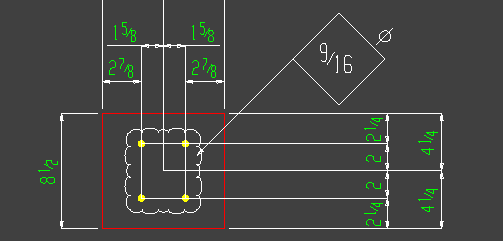
As a result of editing the hole symbol, the symbol is moved from the " System Annotation " layer to the " User Adjusted " layer. Since items on the " User Adjusted " layer are set to be displayed in the color red, the hole symbol is displayed in the color red. 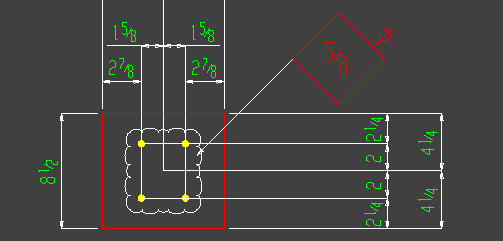
Note: The hole symbol in this example would be moved from the " System Annotation " layer to the " User Adjusted " layer regardless of layer color settings. The layer color settings are for tracking the layer change. They do not affect whether or not such a layer change is made. Also, they do not affect the drawing pen that is assigned to an object.
Detail Rule Annotations: Users in a full-featured SDS2 program can enter to this field the color to be applied to the " Detail Rule Annotations " layer referenced on the Edit Layers window of a Drawing Editor drawing.
Reference Dimension: Users in a full-featured SDS2 program can enter to this field the color to be applied during auto detailing to the " Reference Dimension " layer referenced on the Edit Layers window of a Drawing Editor drawing.
What is a " Reference Dimension " layer? A layer is a means of grouping objects on an SDS2 drawing. Each object in a drawing is on the one " Layer " that is specified on that object's edit window. Since the " Reference Dimension " layer is a comment layer , dimensions on that layer will print only if you choose to "
Plot comment layers " when printing the sheet the drawing has been placed on. Reference dimensions may be placed onto a Reference Dimension comment layer of a submaterial or member detail when the user of a full-featured SDS2 program elects to detail using templates. "Extra" system dimensions might also have been manually moved to the " Reference Dimension " layer by a user of a full-featured SDS2 program. To move a dimension from a non-comment layer to the " Reference Dimension " layer, the user of a full-featured SDS2 program can simply select the dimension's " Layer " on its Edit Dimension window. In SDS2 Site Planning, all objects (dimension, labels, circles, whatever) that are added to a submaterial detail, erection view drawing or system-created member detail are, by default, added to the " Reference Dimension " layer since that layer is the only comment layer that is provided by default on those types of drawings.
User Annotation: Users in a full-featured SDS2 program can enter to this field the color to be applied during auto detailing to the " User Annotation " layer referenced on the Edit Layers window of a Drawing Editor drawing.
What is a " User Annotation " layer? A layer is a means of grouping objects on an SDS2 drawing. Each object in a drawing is on the one " Layer " that is specified on that object's edit window. The user annotation layer typically contains graphic objects (lines, labels, etc.) that a user has added to a drawing. When the user of a full-featured SDS2 program first opens a Drawing Editor drawing that was created by auto detailing , the " User Annotation " layer is automatically selected on the Edit Layers window and the layer selection tool , making the " User Annotation " layer the layer that, by default, users will add new drawing annotations to. In SDS2 Site Planning, on the other hand, objects must always be added to comment layer such as, for example, the " Reference Dimension " layer.
DISCLAIMER: This work flow example can be accomplished in a full-featured SDS2 program . In SDS2 Site Planning, users cannot cause information to be written to the " User Annotation " layer. Users can, however, output a PDF drawing that colorizes those graphics that the user of a full-featured SDS2 program has caused to be placed onto the " User Annotation " layer. In User and Site Options > Output ," Show layer colors on PDFs " is checked (on).

In Drawing Cosmetic s > the " Colors " tab, a " User Annotation " layer color is picked. Then members are auto detailed. 
On the Edit Layers window for a newly detailed Drawing Editor member detail, the " Color " of the layer named " User Annotation " along with the layer itself are both set to be shown ( ).

On the member detail, a label is added stating "User Annotation color = " and a " Fill with solid color " polygon is added. File > Print PDF is used to generate the drawing shown below:
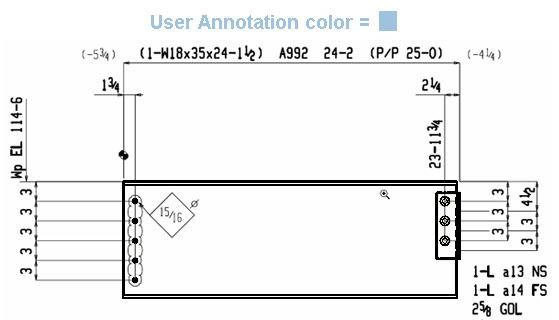
On the PDF drawing (shown above), the label "User annotation color =" is plotted in the color that was specified in Drawing Presentation .
System Annotation: Users in a full-featured SDS2 program can enter to this field the color to be applied during auto detailing to the " System Annotation " layer referenced on the Edit Layers window of a Drawing Editor drawing.
What is a " System Annotation " layer? A layer is a means of grouping objects on an SDS2 drawing. Each object in a drawing is on the one " Layer " that is specified on that object's edit window. The " System Annotation " layer typically contains graphic objects such as dimensions, labels, weld symbols, bevel symbols, hole symbols, etc. that auto detailing in a full-featured SDS2 program has added to annotate materials that are shown on the " Outline " layer. You can find a " System Annotation " layer on member details, erection view drawings and submaterial details, which are drawing types that are created by auto detailing.
DISCLAIMER: This work flow example can be accomplished in a full-featured SDS2 program . In SDS2 Site Planning, users cannot make changes in Drawing Presentation or auto detail members. Users can, however, output a PDF drawing that colorizes graphics that auto detailing in a full-featured SDS2 program has placed onto the " System Annotation " layer. In User and Site Options > Output ," Show layer colors on PDFs " is checked (on).

In Drawing Cosmetic s > the " Colors " tab, a " System Annotation " layer color is picked. Then members are detailed. 
On the Edit Layers window for a newly detailed Drawing Editor member detail, the " Color " of the layer named " System Annotation " along with the layer itself are both set to be shown ( ).

On the member detail, a label is added stating "System Annotation color = " and a " Fill with solid color " polygon is added. File > Print PDF generates the drawing shown below:
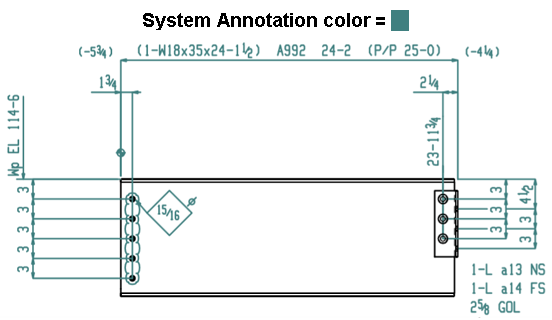
On the PDF drawing (shown above), all system annotations are depicted in the blue-green color specified in Drawing Presentation .
Outline: Users in a full-featured SDS2 program can enter to this field the color to be applied during auto detailing to the " System Annotation " layer referenced on the Edit Layers window of a Drawing Editor drawing.
What is an " Outline " layer? A layer is a means of grouping objects on an SDS2 drawing. Each object in a drawing is on the one " Layer " that is specified on that object's edit window. The outline layer typically contains the material polygons that are the system-generated material that is depicted on the drawing. You can find an " Outline " layer on member details, erection view drawings and submaterial details, which are drawing types that are created by auto detailing.
DISCLAIMER: This work flow example can be accomplished in a full-featured SDS2 program . In SDS2 Site Planning, users cannot make changes in Drawing Presentation or auto detail members. Users can, however, output a PDF drawing that colorizes graphics that auto detailing in a full-featured SDS2 program has placed onto the " Outline " layer. In User and Site Options > Output ," Show layer colors on PDFs " is checked (on).

In Drawing Cosmetic s > the " Colors " tab, a " Outline " layer color is picked. Then members are detailed. 
On the Edit Layers window for a newly detailed Drawing Editor member detail, the " Color " of the layer named " Outline " along with the layer itself are both set to be shown ( ).

On the member detail, a label is added stating "Outline color = " and a " Fill with solid color " polygon is also added. File > Print PDF generates the drawing shown below:

On the PDF drawing (shown above), all system-generated materials and bolts and holes are depicted in the burnt orange color that was originally specified in Drawing Presentation .
New Comment Layer: Users in a full-featured SDS2 program can enter to this field the color to be applied to each new comment layer that is created manually by users, while in any type of a Drawing Editor drawing.
What is a comment layer? Click here for an explanation.
To create a new comment layer for your current Drawing Editor drawing, choose Objects > Layers > Edit All , then press the " Add Comment " button found on the window that opens. Alternatively, you can choose Objects > Layers > Add .
In this work flow example, a new comment layer named " Checked By " is created, then a label with the text "Checked by DLD (2/12/2019)" is added to that comment layer. Due to the " New Comment Layer " having been assigned a shade of yellow, that comment is displayed in that same shade of yellow. In User and Site Options > Drawings ," Show layer colors in Drawing Editor " is checked (on).

On the Edit Layers window for a particular member detail in the Drawing Editor , the " Add Comment " button is pressed, and a new comment layer named " Checked By " is added. The new comment layer's " Color " and the layer itself are both set to be shown ( ).

On the Drawing Editor member detail (shown below), the new " Checked By " comment layer is selected -- on the layer selection tool -- to be the layer to which new objects are added. Objects > Labels > Add is used to write the comment "Checked by DLD (2/12/2019)" to that layer. As you can see in the example below, the new label is highlighted in the "Checked By" comment layer color. 
New Layer: Users in a full-featured SDS2 program can enter to this field the color to be applied to each new non-comment layer that is created manually by users, while in any type of a Drawing Editor drawing. Users of SDS2 Site Planning cannot create new non-comment layers.
page 1 | contents | home > project settings > fabricator > detailing > | classic | top
